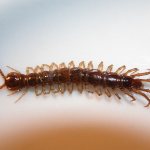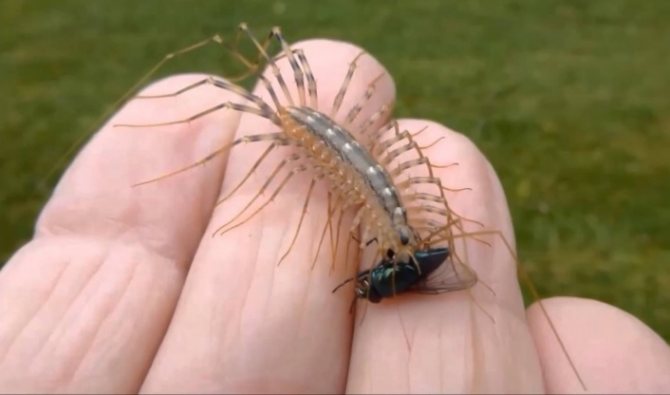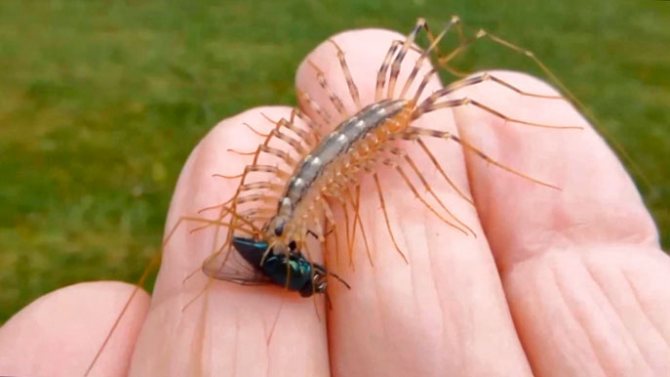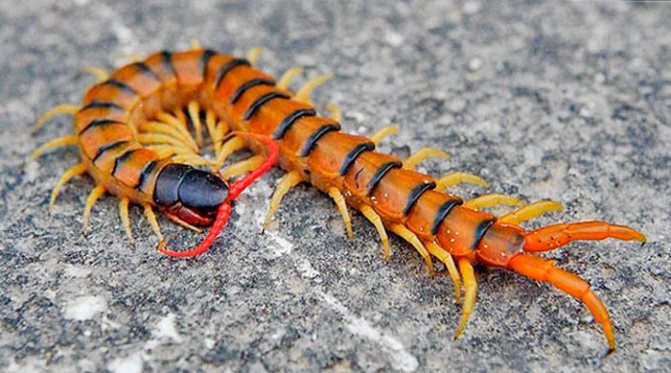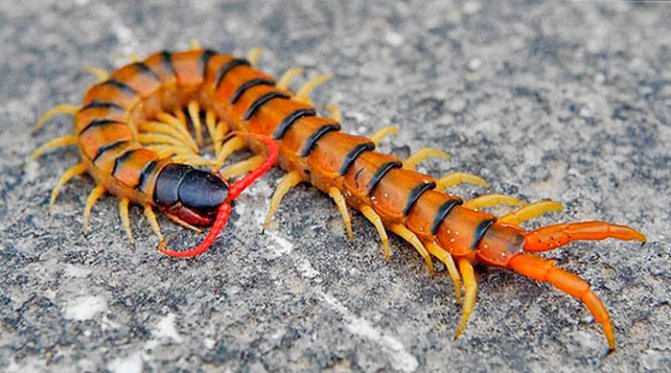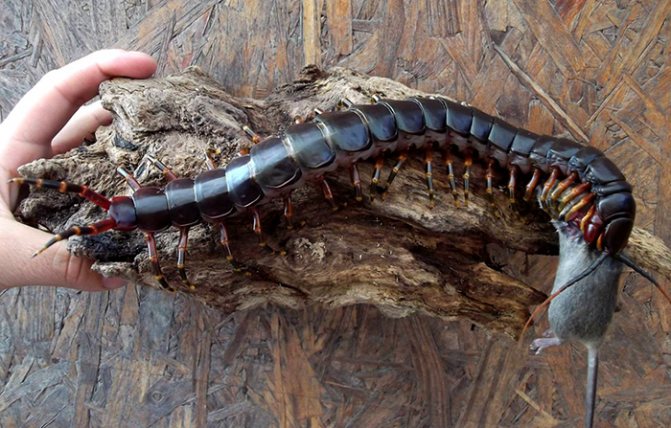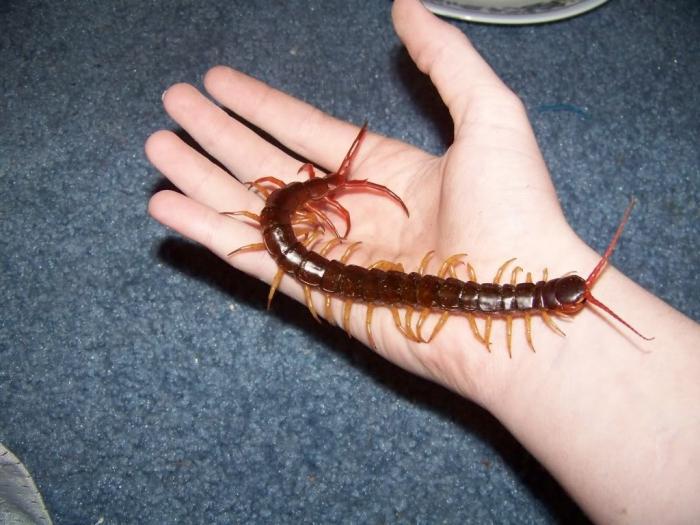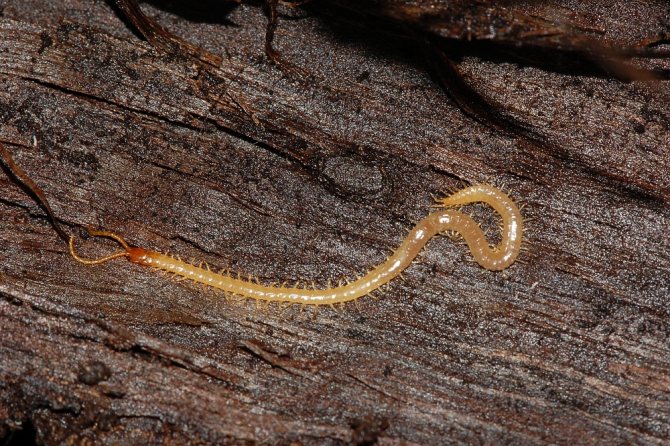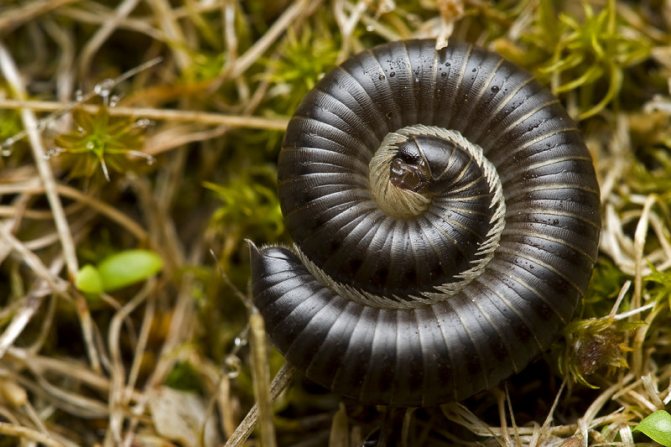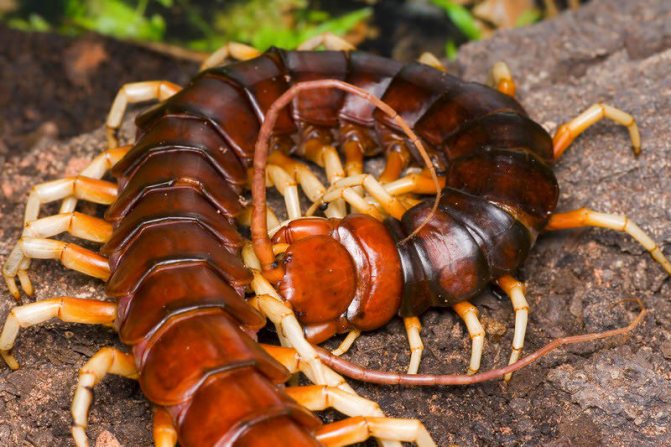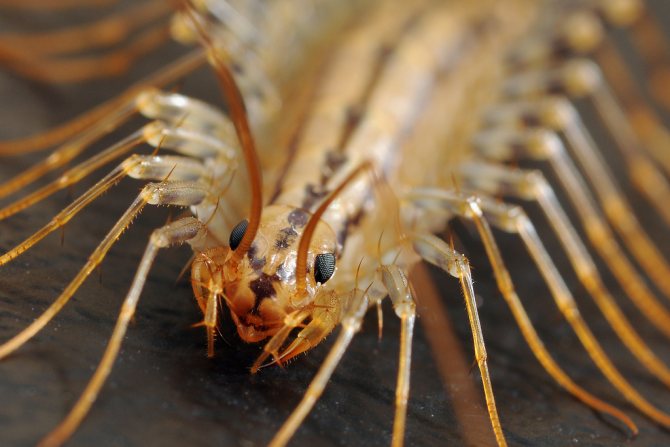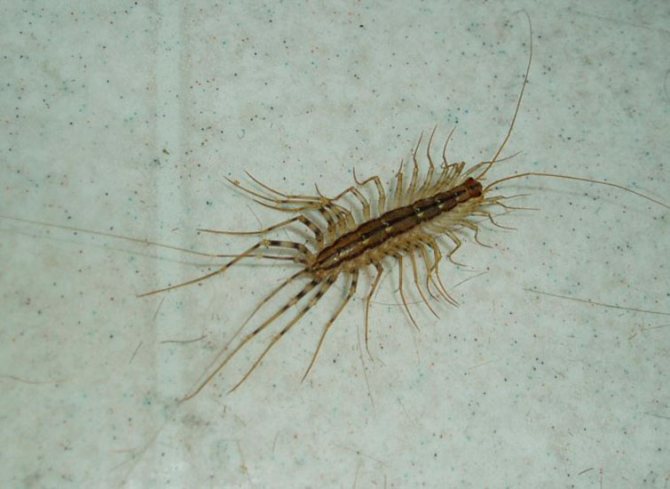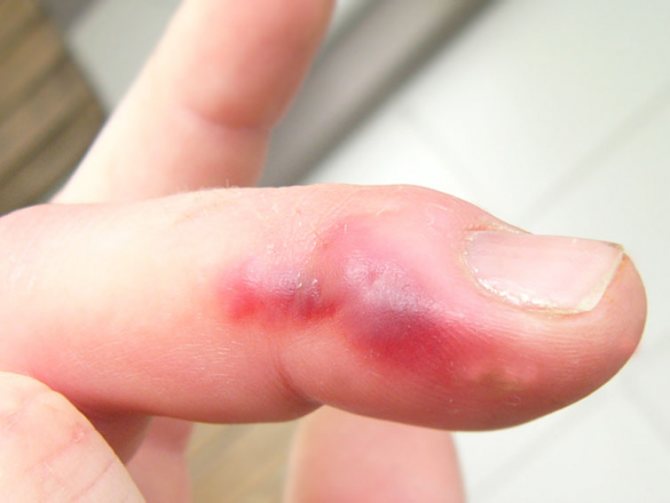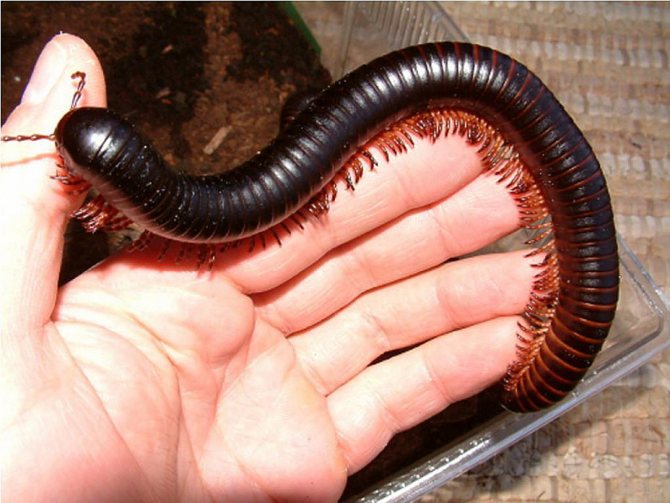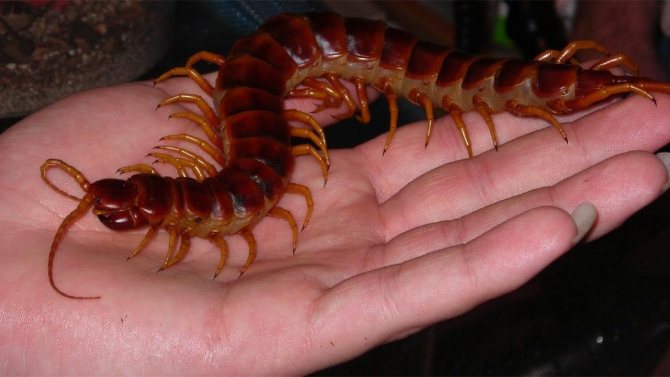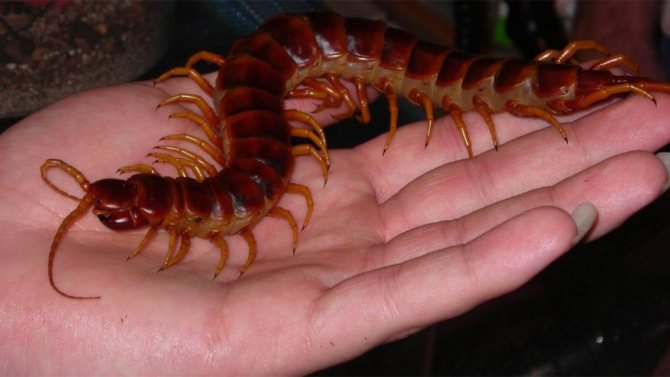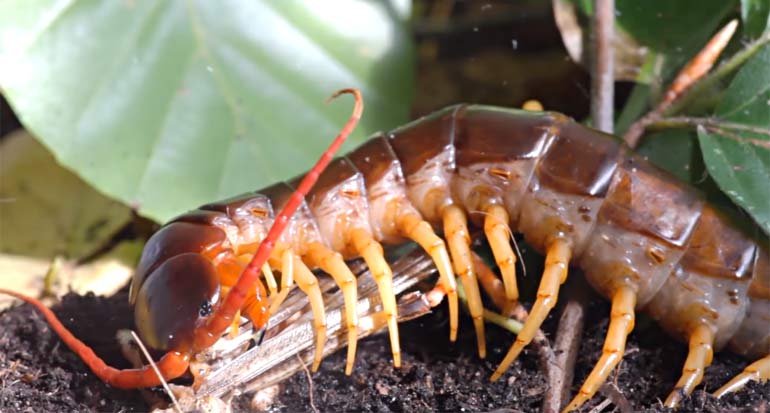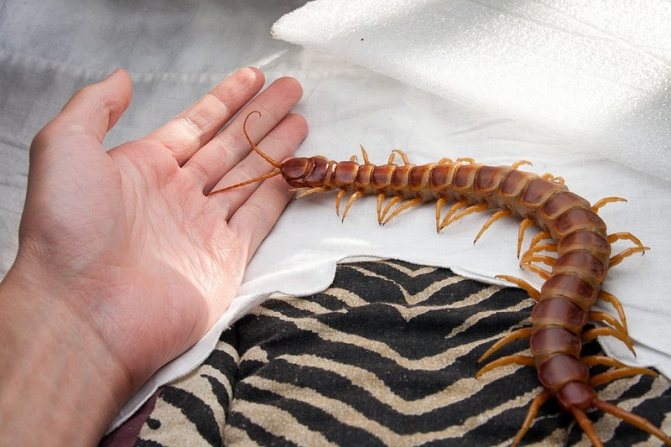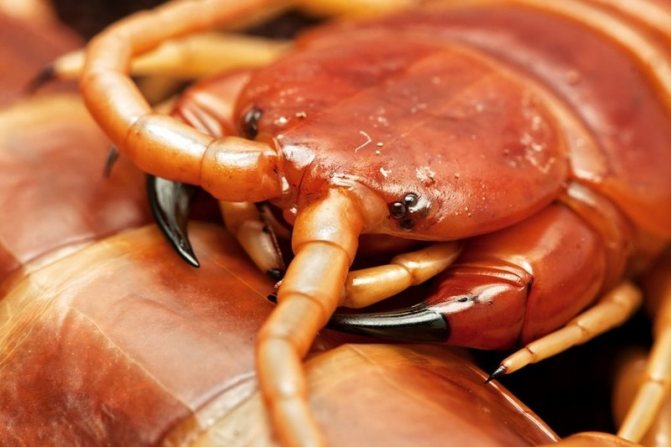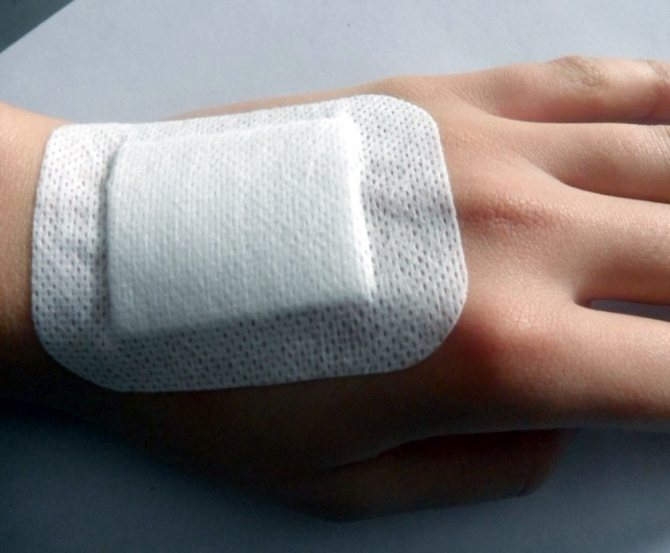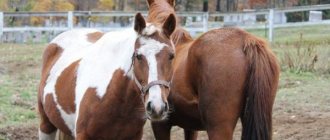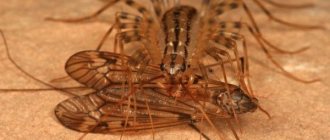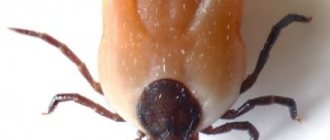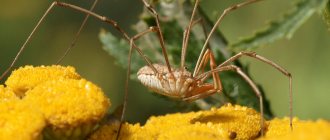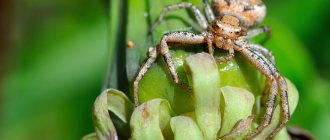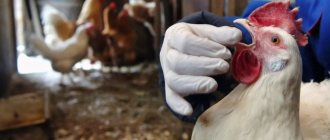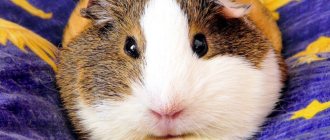Summer is a period of vacations. And everyone strives to spend it where the bright sun shines, the sea waves are splashing, the mountains rise. Diverse flora and fauna of these places are often unusual for a traveler. And although acquaintance with him is very informative, it is sometimes dangerous. So, seriously spoil your summer vacation, maybe the bite of a centipede, a centipede common in southern latitudes. And although its poison is not fatal to humans, it is capable of provoking malaise for several days.
What is this animal and how to make sure that your paths do not cross? Where does centipede live and what to do if she is bitten? Let's figure it out.
How do they look
The body consists of six head segments (three of which are oral), a pair of venomous jaws, a series of leg segments with a trunk, and two genital segments. The heads have two antennae and a varying number of paired compound eyes (called ocelli). Some cave species are blind.
The first pair of limbs extend forward from the body to cover the rest of the mouth. These limbs, or jaws, end in sharp claws and include venom glands that help the animal kill or paralyze prey.
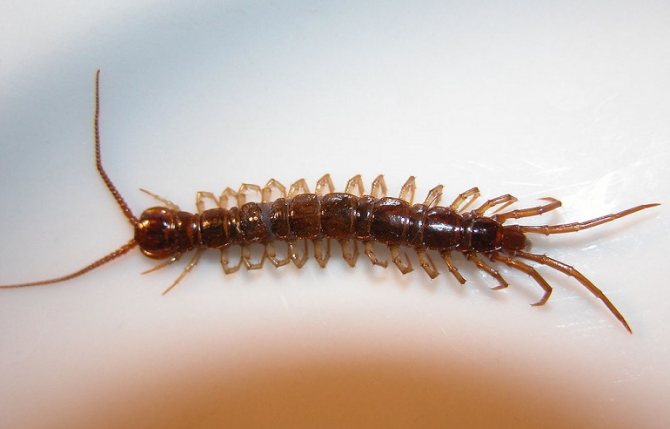
Each pedunculated segment consists of an upper and lower shield covered with a cuticle and separated from the next segment by a flexible membrane. Centipedes periodically shed their cuticles, which allows them to grow. Body length ranges from 4 to 300 millimeters, with most species measuring 10 to 100 mm.
Vision, hearing
The eyes are only able to distinguish between light and darkness and do not have true vision. In some species, the first pair of legs at the head end acts like antennae-like sensory organs, but unlike the whiskers of most other animals, they point backward.
The unusual senses are located at the base of the whiskers and consist of a disc-shaped structure surrounded by sensory cells. They are used to sense vibrations and can even provide hearing.
Teeth
Serration is a unique feature found only in centipedes and no other arthropod. They are modifications of the first pair of legs, forming a pincer-like appendage behind the head.
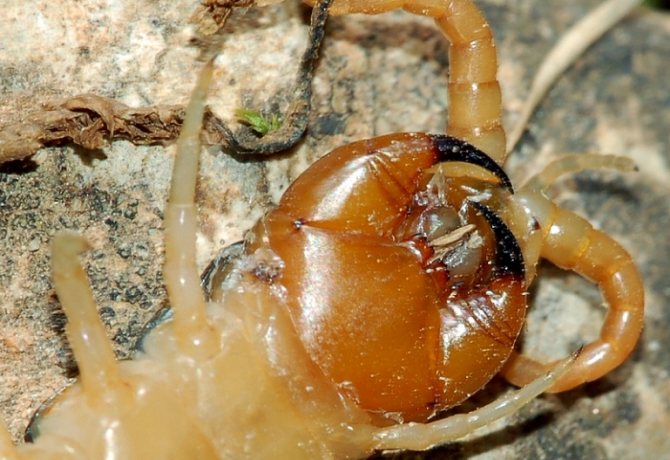

The barbs are not real mouthpieces, although they are used to capture prey, inject poison, and hold captured prey. The venom glands pass through the tube almost to the tip of each head.
Body
The body is made up of 15 or more segments. Most have one pair of legs, with the jaws projecting forward from the first segment of the body. The last two segments are small and legless. Each pair of legs is slightly longer than the pair directly in front of it, which ensures they don't overlap.
This reduces the likelihood of their collision with each other when driving fast. In extreme cases, the last pair of legs can be twice as long as the first. The last segment has a telson and includes the openings of the reproductive organs.
Use antennae to search for prey. The digestive tract forms a simple tube with digestive glands attached to parts of the mouth. Like insects, centipedes breathe through the tracheal system, usually with one opening or spiracle on each body segment. Waste is excreted through one pair of malpighian tubules.
Learn more What it eats, where it hibernates, how long does the common shrew live
Scolopendra gigantea, also known as giant centipede, is the largest existing species in the world, its length exceeds 30 cm. It is known that they eat lizards, frogs, birds, even bats, catching them in flight, as well as rodents, spiders.
Why are people afraid of flycatchers?
The fear and dislike of centipedes on the part of people is mainly due to two facts: aversion to their appearance and the fear that they might climb into the ear. The latter statement is more connected with the common myth about earwigs, which, according to some people, are able to get into the ear of a sleeping person, bite through the eardrum and penetrate the brain. The flycatcher is confused with earwigs, so they are afraid just as much.
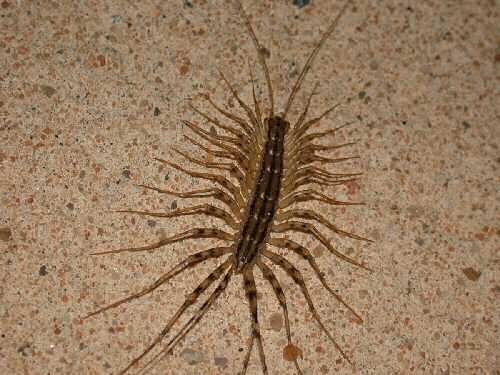

In fact, neither the flycatcher nor the earwig have the intention of getting into human ears, much less capable of gnawing the eardrum and the brain. In addition, they do not need this at all, they do not feed on the brain.
It happens that small insects get into people's ears (most often these are flies, midges or cockroaches). The flycatcher, on the other hand, will not climb into the ear canal under any circumstances - for her there is nothing attractive there and with its length of legs it is completely uncomfortable.
Life cycle
Centipede reproduction does not involve copulation. The males deposit the spermatophore for the female. He is deposited in the web, the male performs a mating dance to induce the female to absorb his sperm. Or, males simply leave the product for the female to find it herself. In temperate areas, oviposition occurs in spring and summer, subtropical and tropical areas, there is little seasonality.
Lithobiomorpha and Scutigeromorpha lay their eggs one at a time in the soil and leave them behind. The number of eggs laid varies from 10 to 50. The time of development of the embryo to hatching varies, it can take from one to several months.
Development time to reproductive period differs within and among species. For example, S. coleoptrata takes 3 years to mature. Under the right conditions, lithobiomorph species can reach reproductive life in 1 year. In addition, centipedes are long-lived compared to other insects.
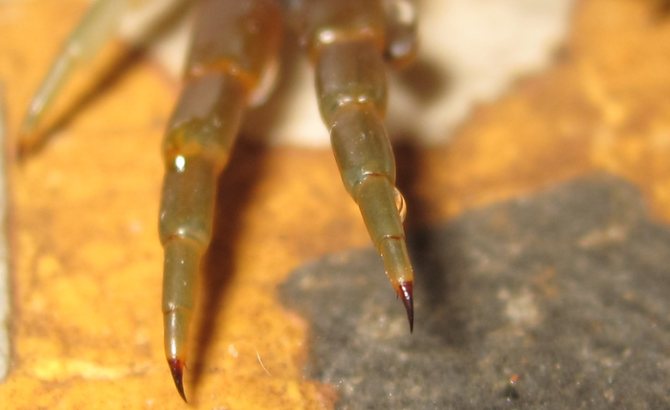

For example, the European Lithobius forficatus lives from 5 to 6 years, Scolopendra subspinipes can live more than 10 years.
Geophilomorpha and Scolopendra females show great parental care. Eggs, in an amount from 15 to 60, are laid in the nest, ground, rotten wood. The female stays with the eggs, guarding and licking them to protect against fungi.
In some species it stays with the young after they have hatched, guarding until they are ready to leave. In case of danger, the female either leaves eggs or eats them. Some species of scolopendra have matrihagia - the offspring eats their mother.
Anamorphic and epimorphic
Centipedes grow legs at different points in development. In Lithobiomorpha, Scutigeromorpha, Craterostigmomorpha, development is anamorphic: more pairs of legs grow between molts.
For example, Scutigera coleoptrata, flycatcher with only four pairs of legs and successive molts. Life stages with less than 15 pairs of legs are called larval stages (about five stages).
Craterostigmomorpha has only one phase of anamorphosis, with embryos having 12 pairs and 15 molts.
Epimorpha, consisting of the orders Geophilomorpha, Scolopendromorpha, demonstrates epimorphism: all pairs of legs are developed in the embryonic stage. The offspring no longer develop legs between molts. These are the longest centipedes.
The maximum number of thoracic segments varies, often geographically. Females have more legs than males.
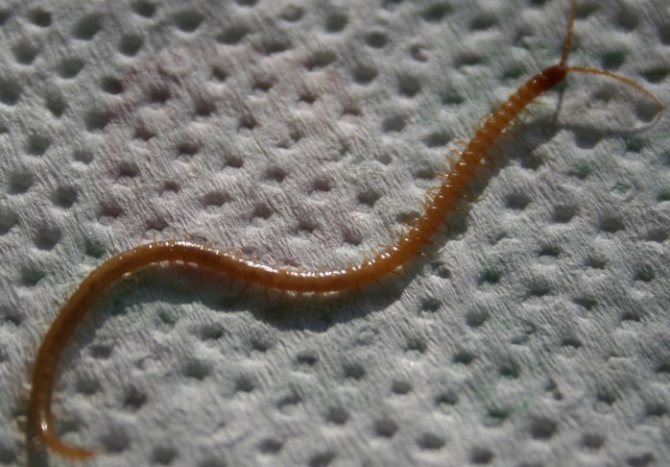

The number of reference segments ranges from 15 to 191. However, they are always added in pairs, so the total is always odd.
Danger to people
Some types of centipedes are dangerous to humans. An adult centipede bite is usually very painful and can cause severe swelling, chills, fever, and weakness. But it is unlikely to be fatal. Dangerous for young children and people with an allergy to bee stings.
In such people, a venomous bite of large scolopendra can cause anaphylactic shock.Smaller specimens are unable to pierce human skin.
Even non-venomous species are considered intimidating due to the fact that their dozens of legs move at the same time, and due to the rapid exit from the darkness.
A 19th century Tibetan poet warned fellow Buddhists, "If you enjoy scaring others, you will be reborn as a centipede."
Insect varieties
There are several dozen species of scolopendra, the main similarity of which is the general features of the structure and a large number of limbs. The giant centipede lives in South America. Due to its large size, small rodents, amphibians and birds can become its victims. The jaws of this centipede are poisonous, an insect with its bite can harm a person (weakness, swelling and pain).
Scootiger usually has a yellow-gray body and long, striped limbs. Its length is about 6 centimeters, it feeds on arthropods and lives in Africa, Kazakhstan, the Caucasus, in the southern part of Russia - in countries with a warm climate. She often lives in fallen leaves, but with the onset of cold weather seeks a warm refuge.
In winter, the scolopendra scooter can end up in a person's dwelling. She is not able to bite through the skin, but her bite can be compared to a wasp. Also, the scooter does not harm furniture and does not spoil food supplies, therefore in some areas it is considered a useful centipede that eats pests. In the photo below you can see what this type of animal looks like.
Ringed species are found in southern European countries and are about 15 centimeters long. It is a dexterous predator that eats arthropods and small reptiles.
Centipede bite
A centipede bite is an injury. Sting-like appendages pierce the skin and inject poison into the wound. Strictly speaking, such a wound is not a bite, since the outgrowths are an altered first pair of legs, and not real mouth parts.
Clinically, it is considered a skin disease characterized by paired hemorrhagic marks that form a chevron shape caused by paired bones.
Centipede venom causes pain and swelling in the area of the bite, and other reactions throughout the body. Most bites are not life-threatening and pose the greatest risk to children and those who develop allergic reactions.
Learn more about Mantis Shrimp: Impact Power
Symptoms
The history of a centipede bite is pretty simple. The victim usually sees and recognizes the insect before or shortly after the bite.
Symptoms that most often develop:
- severe pain, which is usually proportional to the size of the insect;
- swelling, redness;
- skin necrosis;
- local bleeding;
- swollen, painful lymph nodes in the area of the bitten limb;
- headache;
- rapid heartbeat, rapid pulse;
- nausea, vomiting;
- local itching, burning.
The pain caused by a centipede bite has been described as comparable to pain from scorpion stings and snake bites. However, unlike scorpions and snakes, in which some are more venomous than others, the toxicity of centipede venom is uniform across all species.
Therefore, the amount and intensity of pain correlates with the size of the insect. Large scolopendra have large projections that can inject venom deeper under the skin.
The wound is accompanied by swelling, redness, and minor puncture injuries that can form a circle. The trauma is prone to local ulceration and necrosis.
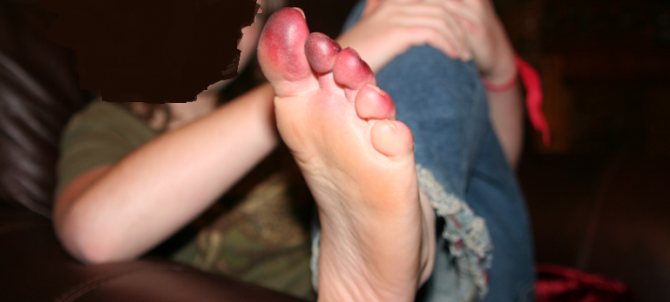

A severe bite from larger species can cause life-threatening anaphylaxis if left untreated. Infections can also occur.
Treatment
First aid consists of rinsing the bite site with cold water. If it doesn't hurt too much, apply ice. It constricts the blood vessels so the poison does not spread. Also recommended is papain, an enzyme that breaks down protein.
Papain can be found in meat tenderizer and papaya. It deactivates most of the proteins in the centipede venom.Depending on the type of insect, treatment may not eliminate all of the venom, and residual pain may persist.
People bitten by centipedes are prescribed a urine test for muscle tissue destruction, an ECG for heart and vascular problems.
Soothing and relieving pain is achieved with pain relievers such as nonsteroidal anti-inflammatory drugs, antihistamines, anti-anxiety drugs. In a severe case, the affected limb is lifted, diuretics are prescribed.
General principles of wound care, sometimes antibiotics are used to prevent a wound from becoming infected or necrotic.
In Barbados, a folk remedy is applying freshly cut onions to the injury site.
Is scolopendra dangerous for humans
This centipede is the primary active-poisonous "armed" animal. That is, it is capable of producing zootoxin in special glands and injecting it into the victim's body using a wounding apparatus. And although the scolopendra is not included in the list of especially dangerous animals, the presence of stinging agents suggests that it is a predator. The centipede is capable of using zootoxin for both attack and defense.
Scolopendra venom contains biologically active substances and proteolytic enzymes that cause local inflammation and act on cells of the nervous tissue. It includes:
- histamine;
- acetylcholine;
- serotonin;
- hyaluronidase;
- thermolysin.
Local symptoms of scolopendra bites occur under the influence of inflammatory mediators. And the nervous system is influenced by neurotransmitters. Moreover, the effect of the poison has a dose-dependent effect. In practice, this means that small animals and insects with a small body weight suffer the most from the scolopendra bite. On them, the neurotoxic effect of the poison is manifested by adynamia, increased salivation, constriction of the pupil, fasciculation (twitching) of muscles, impaired breathing and coordination of movements, paralysis.
The specificity of the action of zootoxins on humans is reflected in the International Classification of Diseases of the tenth revision. The toxic effect resulting from contact with poisonous animals, including the bite of a scolopendra, is included in the ICD-10 code T63.4.
The venom of a centipede is dangerous to humans only if there is an individual intolerance to one or more of the substances that make up it. Bites to the head and neck, to the area of blood vessels are also dangerous. Young children are at risk. A fatal case was described when a child was bitten in the head by an Asian centipede.
What do they eat
Centipedes are predominantly versatile predators, which means they have adapted to consume the variety of prey available. A study of the contents of the intestines shows that plant material is an unimportant part of their diet. They feed on plant matter when they are hungry.
They are nocturnal insects. What centipedes actually eat is unknown due to their mysterious lifestyle and thorough chewing. It usually wraps around the prey and waits for the poison to take effect before eating it.
Scolopendra, given their size, are capable of feeding on vertebrates. Have been seen eating reptiles, amphibians, small mammals, bats, and birds. Centipedes and spiders hunt each other.
Two species, Scolopendra cataracta and S. paradoxa, are known to be amphibians and prey on aquatic or amphibious invertebrates.
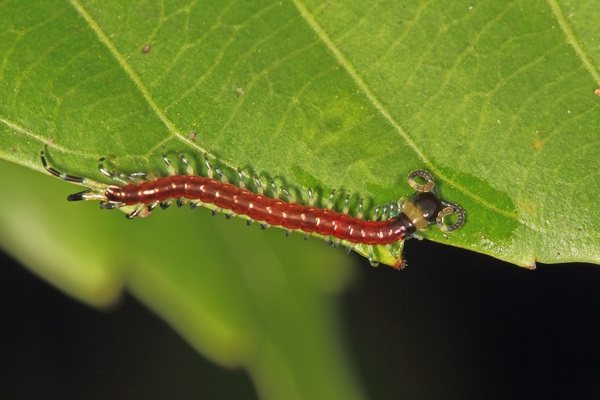

Many large animals prey on centipedes such as mongooses, mice, salamanders, beetles, and snakes. They are the staple food of the African Amblyopone Pluto ant, the lake snake Aparallactus capensis.
Centipede defenses - speed, poison, release of protective chemicals.The geophilomorph releases sticky substances that generate toxic hydrogen cyanide and benzoic acid from microscopic glands on the underside. Likewise, lithobiomorphic centipedes secrete a sticky substance from the glands of the two rear pairs of legs.
Fluid regulation is an important aspect of life. They lose water quickly in dry conditions. The loss of water is the result of not having a wax coating on the exoskeleton and releasing waste nitrogen in the form of ammonia, which requires additional water.
Habitats - forest, savannah, prairie, desert, and many others. Some are adapted to coastal habitats where they feed on barnacles. Species of all orders, with the exception of Craterostigmomorpha, have adapted to caves.
Learn more about Rat traps and rat traps
Traditional methods
Scolopendra are often found in private houses and cottages where families, children, and animals live. Fighting with chemicals is not always appropriate. Often, residents use traditional methods, for example, hot cayenne pepper (powder), pouring in places where insects accumulate. It is also advisable that they run over the peppers or eat them.
First of all, it is important to eliminate the food supply for the centipede, i.e. remove ants, cockroaches, bedbugs and spiders so that there is no food to feed
And without her there will be simply nothing to feed on.
Of course, when large hordes appear, you can contact a specialized service. Professionals will quickly cleanse the house of uninvited guests by acting on them with thermal methods or chemical compounds, synthetic pyrethroids. So the processing can be done quickly. One procedure is enough for scolopendra to leave the house forever and not to appear in the future.
Are they eaten?
Certain types of large size are consumed as food in China, usually grilled or deep fried. They can often be seen in the kiosks of street vendors in large cities, in the markets of Donghuamen, Wangfujing Beijing.
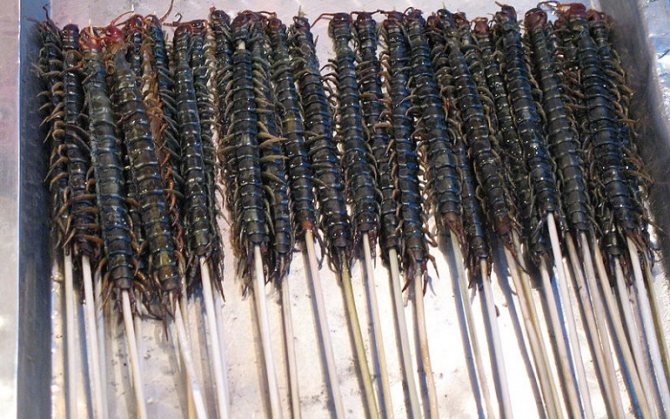

Also in China, Laos, Thailand, Cambodia, large centipedes are used for tincture and dried. This practice is part of traditional Chinese medicine. It is believed that they have medicinal properties, give strength, liqueur with a centipede immersed in it is used as a special medicinal drink.
Difference from millipedes
The easiest way to tell a centipede from a centipede is as follows: centipedes have two pairs of legs on most body segments, centipedes always have one pair of legs per segment. Not sure what you found? Just count how many pairs of legs there are in the segment.
The number of legs changes throughout life
If the centipede finds itself in the grip of a bird or other predator, it can escape by sacrificing a few legs. The bird has a beak full of legs, a cunning insect quickly runs away on the rest. Since they continue to shed all their lives, they quickly repair the damage.


If you find a centipede with multiple legs that is shorter than the others, it is most likely recovering from a predator attack.
Centipedes as pets
Most of the insects sold as pets are from the wild. Most often sold giant centipedes from the genus Scolopendra. Contained in terrariums with a large surface area of at least 60 centimeters (24 inches).
Burying requires an embedded substrate of soil and coconut fiber. They are fed pre-killed crickets, cockroaches, mealworms weekly or every two weeks. A shallow dish of water is required.
Centipedes are aggressive, poisonous and potentially dangerous to humans, especially children. Centipede bites cause skin damage, bruising, blisters, inflammation, and gangrene. The terrarium must be protected from escaping.
While they can't climb smooth glass or acrylic, don't let them climb onto the lid.A minimum humidity of 70 percent is required, more for rainforest species. Adequate ventilation is provided by a grill cover and small openings on the side of the enclosure.
Make sure the holes are small to prevent insects from crawling through them. Temperate species are kept at temperatures between 20-25 C (68-72 F), tropical 25-28 C (77-82.4 F).
Don't worry if you don't see your pet during the day: centipedes are nocturnal creatures that hunt after dark.
Giving help
The Crimean scolopendra should beware of being in nature. She attacks tourists or vacationers who stayed overnight in the forest or on the beach. You can also get a millipede bite at home, living in an insufficiently isolated apartment. Due to the fact that scolopendra is nocturnal, it is not always possible for a person to feel the bite of a sleeping person at home. First aid for a scolopendra bite is to carry out the following procedures:
- the damaged bite site is washed with water using antibacterial (laundry) soap;
- in view of the fact that various bacteria and rotting particles can be found on the limbs of the scolopendra, you need to know how to treat the bite, usually I use an antiseptic to disinfect the wound: hydrogen peroxide or medical alcohol;
- Levomikol ointment will help to avoid tissue suppuration;
- you can protect the damaged area of the skin from infection with a sterile bandage;
- the puffiness that appears is removed with a cold compress or ice;
- it is possible to reduce pain by means of painkillers (Ketanov or Ibuprofen), they also take an analgesic;
- toxins are removed from the body by taking a large amount of clean water;
- if the victim was a child, as well as a person suffering from allergies or with pathology of the cardiovascular system, then a doctor's consultation is imperative;
- you should also seek medical help if, after a bite, a person feels unwell and his temperature rises, and severe swelling appears.
Do not panic if you are bitten by a scolopendra in the Crimea. The consequences of a bite, which are expressed in the form of burning and swelling, will pass within 1-2 days.
First aid for a scolopendra bite in nature is provided in a similar way. It is enough to wash the wound with soap and water, and then treat the bite site with hydrogen peroxide or alcohol tincture. Next, you should apply a sterile bandage and drink anesthetic. In case of deterioration of the victim's condition, it is necessary to take measures to deliver him to a medical institution, where he will be prescribed a drug of the group of analgesics and will be prevented from tetanus.
Alcohol contributes to the fastest absorption of the poison by the body, causing the acceleration of blood flow. Therefore, its adoption in such situations is unacceptable. You can also not apply a tourniquet above or below the bite site. This can lead to tissue necrosis and the development of gangrenous phenomena. It is also not recommended to cauterize the damaged area and cut the skin to remove the poison.

